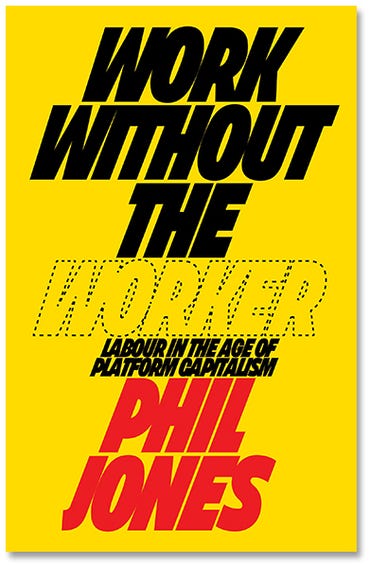
Work Without the Worker: Labour in the Age of Platform Capitalism • By Phil Jones • Verso • 144 pages • ISBN: 978-1-83976-043-3 • £10.99
“Will we be retired — or unemployed?” the leader of a futurist conference asked in 2007 while envisioning a world filled with AIs possessed of superhuman intelligence. More recent — and more restrained — researchers such as Kate Darling have argued that our best option lies in human-machine partnerships, although with the caveat suggested by Madeleine Claire Elish in her paper Moral Crumple Zones that the human partner will be the one that gets the blame when things go wrong.
However, in the vast majority of the human-machine partnerships already in existence, the human partner is one or more invisible microtask workers being paid tiny amounts to label images, remotely take over a faltering delivery drone, or transcribe bits of text.
We have seen these workers’ lives documented before — for example, in Mary L. Gray and Siddharth Suri’s 2019 book Ghost Workers, Sarah T. Roberts’ 2019 book Behind the Screen, and Kate Crawford’s recent book on the extractive nature of the AI industry, Atlas of AI. In Work Without the Worker: Labour in the Age of Platform Capitalism, Phil Jones sets these workers in a larger global context.
SEE: Managers aren’t worried about keeping their IT workers happy. That’s bad for everyone
But first, some numbers. As Jones documents, the number of microtaskers is huge and growing. There are 12 million at China’s Zhubajie, two million at Clickworker, over one million at Appen. In the UK, according to surveys, as much as 5% of the working-age population uses these platforms at least once a week. This is an event in which scale matters: the more of the labour force that is shifted to and splintered across microtasking platforms with terms and conditions, the easier it is for workers’ rights to be eroded in the “economy of clicks”.
Temporary adjustment, or permanent reality?
Is the rise of precarious microtasking temporary, while the workforce reskills and reconfigures — as has been the case historically, and as the technology companies like to predict will happen this time, too? Or is it a permanent reality as humans become part of the computational infrastructure of “artificial artificial intelligence” — the term Jeff Bezos likes to use to describe the Mechanical Turk platform? (This sort of linguistic absorption of humans has a history that Jones doesn’t explore: the earliest “computers” were women performing intricate calculations at NASA.)
Jones argues that today’s conditions are different: what we’re seeing is jobs being carved up into tasks, a process that transforms professionals into “wage hunter-gatherers”. Instead of creating new ranges of occupations, this market is creating “market fugitives” who must wait until a piece of work becomes available. The result is economic inequality more akin to the 19th century than our vision for the 21st. In Jones’s darkest chapter, workers are paid pennies to train the AIs that will eventually replace them entirely.
Jones ends on a hopeful note as microworkers begin to organise, partly driven by hopes that the post-pandemic world can be built to be fairer. In an epilogue, he explores the “post-scarcity” world. If today’s microwork automates our jobs away, what then? Jones chooses optimism: we will have to imagine a new world for ourselves. In terms of that 2007 question, his best hope for us is happy retirement.
RECENT AND RELATED CONTENT
Unsupervised AI arrives for quality inspection
Workers obsolete as robots do the dirty work
There’s been a big rise in monitoring workers at home. We should all be worried
Industry 4.0 gets its first unicorn
Your people are your most important technology asset
Read more book reviews




















